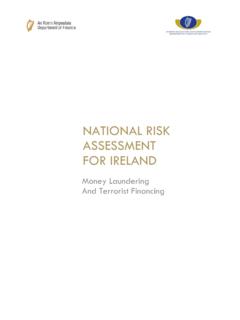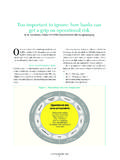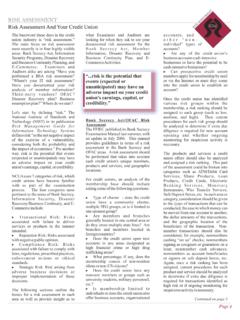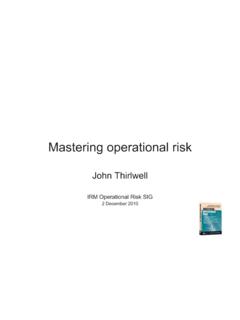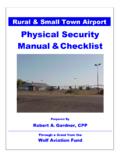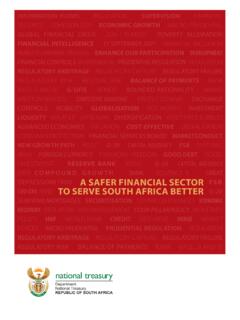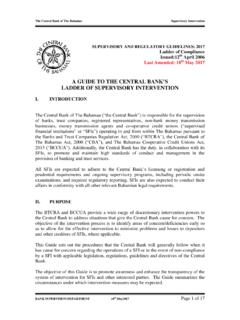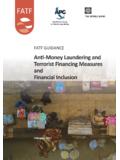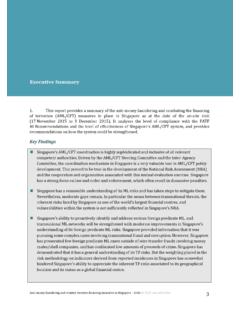Transcription of Fraud Risk Assessment and Effective and …
1 EGESIF_14-0021-00 16/06/2014 EUROPEAN COMMISSION DIRECTORATE-GENERAL European Structural and Investment Funds Guidance for Member States and Programme Authorities Fraud Risk Assessment and Effective and Proportionate Anti- Fraud Measures June 2014 DISCLAIMER: "This is a working document prepared by the Commission services. On the basis of applicable EU law, it provides technical guidance for public authorities, practitioners, beneficiaries or potential beneficiaries, and other bodies involved in the monitoring, control or implementation of the European Structural and Investment Funds on how to interpret and apply EU rules in this area. The aim of this document is to provide Commission services' explanations and interpretations of the said rules in order to facilitate programme implementation and to encourage good practice(s). However this guidance is without prejudice to the interpretation of the Court of Justice and the General Court or decisions of the Commission.
2 " 2 Table of Contents LIST OF ACRONYMS AND ABBREVIATIONS .. 3 1. 5 5 A proactive, structured and targeted approach to managing Fraud 6 2. DEFINITIONS .. 7 Definition of 7 3. Fraud RISK SELF- Assessment .. 8 The 8 Composition of the self- Assessment 9 Frequency of the self- Assessment .. 10 4. GUIDANCE ON MINIMUM REQUIREMENTS FOR Effective AND PROPORTIONATE ANTI- Fraud MEASURES .. 10 Anti- Fraud policy .. 10 11 Ethical 12 Allocation of 12 Training and awareness raising .. 12 Internal control 13 Data analytics and the ARACHNE tool .. 13 Detection and reporting .. 14 Developing an appropriate mind-set .. 14 Fraud indicators (red flags) .. 14 Investigation, correction and 15 Recovery and criminal prosecution .. 16 Follow-up .. 16 5. AUDIT BY THE AA OF THE MA'S Fraud RISK Assessment AND ITS ANTI- Fraud MEASURES .. 16 Checklist for AAs .. 16 Frequency of the AA s verification.
3 16 Annex 1 Fraud risk Assessment tool and instructions on how to use the tool Annex 2 Recommended mitigating controls Annex 3 Template for anti- Fraud policy Annex 4 Checklist for the AA 3 LIST OF ACRONYMS AND ABBREVIATIONS AA Audit Authority CA Certifying Authority "the CPR" Common Provisions Regulation (Regulation (EU) No 1303/2013 of the European Parliament and of the Council of 17 December 2013, laying down common provisions on the European Regional Development Fund, the European Social Fund, the Cohesion Fund, the European Agricultural Fund for Rural Development and the European Maritime and Fisheries Fund and laying down general provisions on the European Regional Development Fund, the European Social Fund, the Cohesion Fund and the European Maritime and Fisheries Fund and repealing Council Regulation (EC) No 1083/2006) ERDF European Regional Development Fund ESF European Social Fund The Financial Regulation Council Regulation (EC, Euratom) No 1605/2002 of 25 June 2002 on the Financial Regulation applicable to the general budget of the European Communities "the Funds" for this document specifically, this means: the European Regional Development Fund, the European Social Fund, the Cohesion Fund and the European Maritime and Fisheries Fund IB Intermediate Body MA Managing Authority OLAF European Anti- Fraud Office 4 EXECUTIVE SUMMARY This guidance note provides assistance and recommendations to managing authorities (MAs) for the implementation of Article 125(4)(c) CPR, which lays down that the MA shall put in place Effective and proportionate anti- Fraud measures taking into account the risks identified.
4 The Commission also provides guidance for the audit authority's (AA) verification of the compliance of the MA with this article. The Commission recommends that MAs adopt a proactive, structured and targeted approach to managing the risk of Fraud . For the Funds, the objective should be proactive and proportionate anti- Fraud measures with cost- Effective means. All programme authorities should be committed to zero tolerance to Fraud , starting with the adoption of the right tone from the top. A well-targeted Fraud risk Assessment , combined with a clearly communicated commitment to combat Fraud can send a clear message to potential fraudsters. Effectively implemented robust control systems can considerably reduce the Fraud risk but cannot completely eliminate the risk of Fraud occurring or remaining undetected. This is why the systems also have to ensure that procedures are in place to detect frauds and to take appropriate measures once a suspected case of Fraud is detected.
5 The guidance is intended to help as a step-by-step guide to addressing any remaining instances of Fraud once other sound financial management measures have been put in place and are implemented effectively. However, the overall objective of the regulatory provisions is cost- Effective Fraud risk management and the implementation of Effective and proportionate anti- Fraud measures, which in practice means a targeted and differentiated approach for each programme and situation. Therefore, the Fraud risk self- Assessment tool which is attached to this guidance note, together with detailed instructions, can be used to assess the impact and likelihood of common Fraud risks occurring. Secondly, the guidance indicates the recommended mitigating controls which could help further reduce any remaining risks , not yet effectively addressed by current controls.
6 The operational objective for the MA should be to deliver Fraud responses which are proportionate to the risks and tailored to the specific situations related to the delivery of the Funds in a particular programme or region. Notably, following this risk Assessment and related mitigating controls put in place at system level, managing authorities are recommended to address specific situations which may arise at the level of implementation of operations by further developing specific Fraud indicators (red flags) and by ensuring Effective cooperation and coordination between the managing authority, the audit authority and investigative bodies. The Commission will also assist Member States by offering a specific risk scoring tool, ARACHNE, which will help to identify, prevent and detect risky operations, projects, beneficiaries and contracts/contractors and will serve also as a preventive instrument.
7 The Fraud risk self- Assessment proposed by the Commission is straightforward, logical and practical and is based on five main methodological steps: 1. Quantification of the risk that a given Fraud type would occur by assessing impact and likelihood (gross risk). 2. Assessment of the effectiveness of the current controls in place to mitigate the gross risk. 3. Assessment of the net risk after taking into account the effect of any current controls and their effectiveness the situation as it is at the current time (residual risk). 5 4. Assessment of the effect of the planned mitigating controls on the net (residual) risk. 5. Defining the target risk, i e the risk level which the managing authority considers tolerable after all controls are in place and Effective . Finally, the Commission plans to provide targeted roll-out support, when needed, to assist Member States in implementing Article 125(4)(c) CPR and this guidance.
8 1. INTRODUCTION Background According to Article 59(2) of the Financial Regulation, Member States shall take all necessary measures, including legislative, regulatory and administrative measures, to protect the EU's financial interests, namely by preventing, detecting and correcting irregularities and Fraud . The CPR includes specific requirements in relation to Member States' responsibility for Fraud prevention. This guidance on Fraud risk management is addressed to the MAs and AAs of the European Regional Development Fund (ERDF), the Cohesion Fund and the European Social Fund (ESF) and the European Maritime and Fisheries Fund (EMFF). Apart from Article 72(h) CPR , which sets out that the management and control systems shall provide for the prevention, detection and correction of irregularities, including Fraud , and the recovery of amounts unduly paid, together with any interest, Article 125(4)(c) CPR lays down that the MA shall put in place Effective and proportionate anti- Fraud measures taking into account the risks identified.
9 Fraud and corruption risks should be adequately managed. MAs have a responsibility to demonstrate that attempts at defrauding the EU budget is unacceptable and will not be tolerated. Dealing with Fraud , and its causes and consequences, is a significant challenge to any management, as Fraud is designed to avoid detection. MAs are also advised to take notice of Transparency International's Corruption Perception Index1 and the EU anti-corruption report prepared by the Commission2, when assessing to what extent its overall operating environment is perceived to be exposed to potential corruption and Fraud . The potential for Fraud cannot be ignored and should be seen as a set of risks to be adequately managed alongside other business risks or potentially negative events. Assessment of Fraud risks can therefore be carried out using existing risk management principles and tools.
10 Effectively implemented robust control systems can reduce the risk that Fraud occurs or remains undetected but cannot eliminate the likelihood of Fraud occurring. The overall objective should be to address the main Fraud risks in a targeted manner, keeping in mind that apart from baseline requirements the overall benefit of any additional anti- Fraud measures should exceed their overall costs (the principle of proportionality), taking also into account the high reputational cost linked to Fraud and corruption. 1 2 Communication from the Commission to the European Parliament, the Council and the European Economic and Social Committee of 6 June 2011 Fighting corruption in the EU (COM(2011)308 final). 6 In order to assess the impact and likelihood of any potential Fraud risks which could harm the EU's financial interests, the Commission recommends that MAs use the attached Fraud risk Assessment tool in Annex 1.










